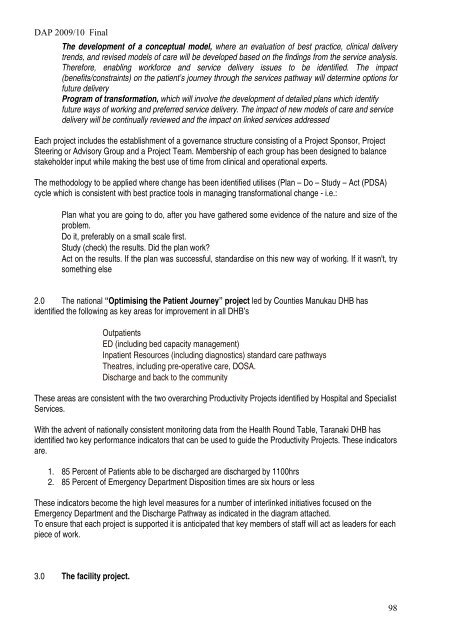DAP 2009/10 Final 1 - Taranaki District Health Board
DAP 2009/10 Final 1 - Taranaki District Health Board
DAP 2009/10 Final 1 - Taranaki District Health Board
Create successful ePaper yourself
Turn your PDF publications into a flip-book with our unique Google optimized e-Paper software.
<strong>DAP</strong> <strong>2009</strong>/<strong>10</strong> <strong>Final</strong>The development of a conceptual model, where an evaluation of best practice, clinical deliverytrends, and revised models of care will be developed based on the findings from the service analysis.Therefore, enabling workforce and service delivery issues to be identified. The impact(benefits/constraints) on the patient’s journey through the services pathway will determine options forfuture deliveryProgram of transformation, which will involve the development of detailed plans which identifyfuture ways of working and preferred service delivery. The impact of new models of care and servicedelivery will be continually reviewed and the impact on linked services addressedEach project includes the establishment of a governance structure consisting of a Project Sponsor, ProjectSteering or Advisory Group and a Project Team. Membership of each group has been designed to balancestakeholder input while making the best use of time from clinical and operational experts.The methodology to be applied where change has been identified utilises (Plan – Do – Study – Act (PDSA)cycle which is consistent with best practice tools in managing transformational change - i.e.:Plan what you are going to do, after you have gathered some evidence of the nature and size of theproblem.Do it, preferably on a small scale first.Study (check) the results. Did the plan work?Act on the results. If the plan was successful, standardise on this new way of working. If it wasn't, trysomething else2.0 The national “Optimising the Patient Journey” project led by Counties Manukau DHB hasidentified the following as key areas for improvement in all DHB’sOutpatientsED (including bed capacity management)Inpatient Resources (including diagnostics) standard care pathwaysTheatres, including pre-operative care, DOSA.Discharge and back to the communityThese areas are consistent with the two overarching Productivity Projects identified by Hospital and SpecialistServices.With the advent of nationally consistent monitoring data from the <strong>Health</strong> Round Table, <strong>Taranaki</strong> DHB hasidentified two key performance indicators that can be used to guide the Productivity Projects. These indicatorsare.1. 85 Percent of Patients able to be discharged are discharged by 1<strong>10</strong>0hrs2. 85 Percent of Emergency Department Disposition times are six hours or lessThese indicators become the high level measures for a number of interlinked initiatives focused on theEmergency Department and the Discharge Pathway as indicated in the diagram attached.To ensure that each project is supported it is anticipated that key members of staff will act as leaders for eachpiece of work.3.0 The facility project.98
















